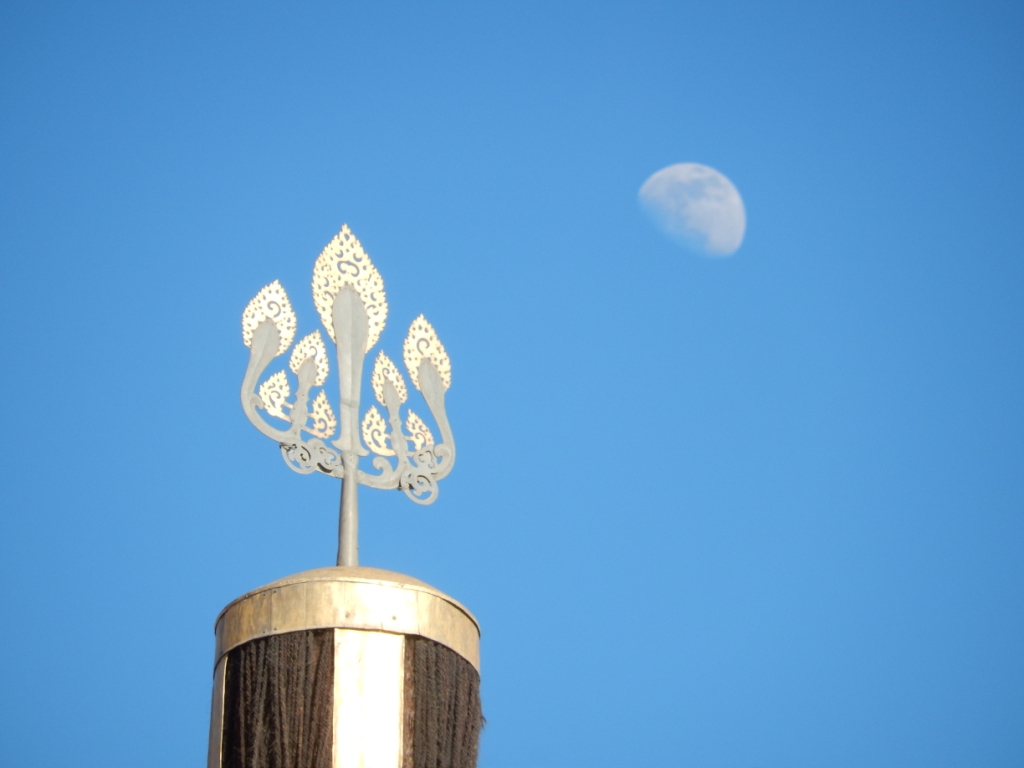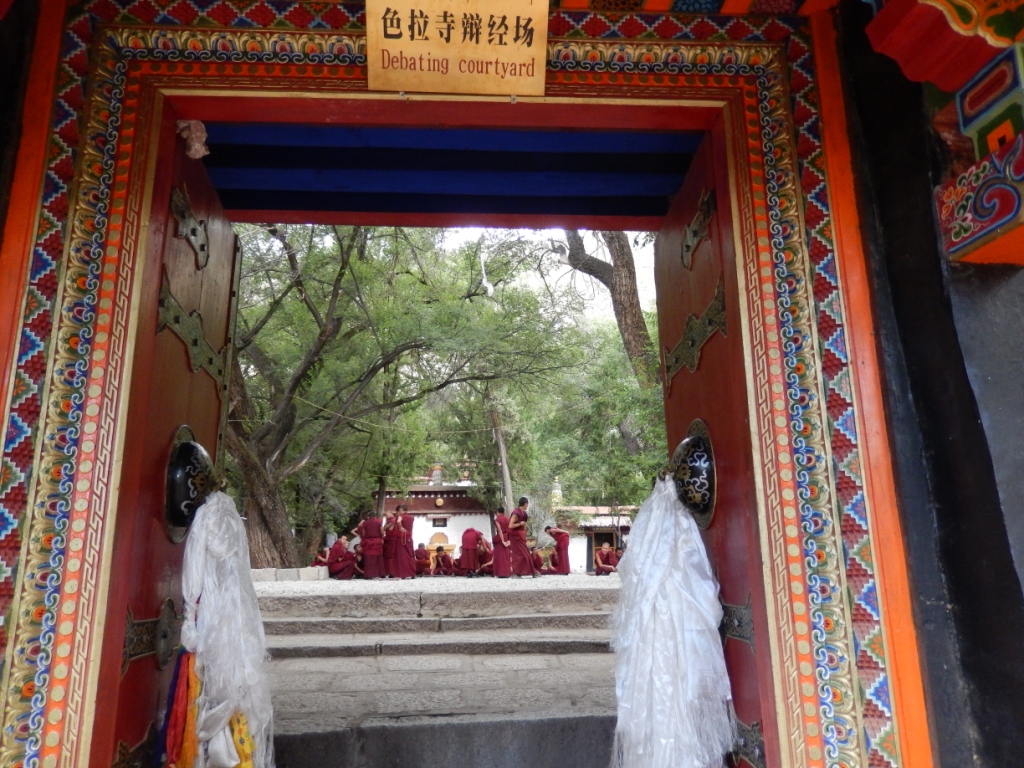It was hard to say bye to Lhasa. We'd been wandering the streets around the Jhokang Temple and Bharkor street for over 10 days.
Our last afternoon was spent doing another kora, walking around the Jhokang Temple with the worshippers and saying bye in the late evening sun.

Above is my favourite photo of Lhasa – The last afternoon sun hitting the top of the Jhokang temple, with the moon in the background.
We were so lucky to have such great blue-sky weather in Tibet.
Here are some of our favourite memories:
This was taken after being blessed at Tamjing Temple (Horse-head Buddha), in the Sera Monastery compound. Most tourists don't go to this temple, most of them go to see the monk debate. Our lovely guide, Dekyi from Road To Tibet Tours took us to the local temple area where she asked the monk to bless us for the rest of our journey (those black marks on our noses are from the blessing).
As with most temples, we were not allowed to take pictures inside, but I have to talk about the Tibetan warmth and welcome. The most amazing part for me was that the locals, who were in line waiting to see the monk, happily let us through the queue to get to the shrine of the horse-head Buddha first. As they went through the entire temple, stopping at other shrines & dieties, Dekyi explained that we wanted to see the horse-headed Buddha shrine, they smiled, and let us go ahead. We bowed, Thanked and said "Sorry" many many times, and never did we ever get the stink-eye or hear a cross-word. The Tibetans were happy to share their religion with us when asked if we could go ahead to the last shrine. It was really such a beautiful experience to be accepted so warmly and allowed to join in with their religion.
And don't be fooled, we weren't paying the temple anything, we weren't paying the locals…we were just basically jumping the line…and we weren't "real" Buddhists.
The monk debate at Sera Monastery. This is the part most tourists see, and it was fascinating. The monks take turns "asking" questions. The 2 seated monks have to answer questions based on the scriptures, and the standing monk asks the questions. If the seated monk answers correctly, the standing monk with clap his hands (palms together). If the answer is wrong, the standing monk with slap the back of one hand into the palm of the other hand. It was a very loud and jovial debate….lots of pointing, shouting, smiling, laughing….no aggression but there was also a sense of seriousness, that this wasn't done for show.
Once the session is over, the standing monk then swaps positions with another seated monk and more questions are asked.

Late afternoon sun at the front of the Jhokang Temple. Our last "kora" walking around with the locals around the prayer flags. I'll miss that daily ritual of walking around Jhokang in a clockwise direction with the locals.
 Colours of the prayer flags – it's such a quintessential part of Tibet and Lhasa. The colours, the scriptures…..A city where religion is a way of life and practiced daily.
Colours of the prayer flags – it's such a quintessential part of Tibet and Lhasa. The colours, the scriptures…..A city where religion is a way of life and practiced daily.
These monks were standing at the top of the Jhokang Temple, on our last day in Lhasa. With the evening sun beating down, they were looking across the square.
Our "local" temple, which we always felt welcomed at. This was a small temple, along the "kora" walk outside the Jhokang. This smaller temple is called Ma Neh Ha Kang.
Ma Neh = 6 words (Om Ma Nai Pad Mai Hung)
Ha = Buddha
Kang = Temple/ House
On the outside are prayer wheels, so we would do a mini "kora" around it, then enter. Inside is housed a gigantic prayer wheel – so big that the entire room is almost taken up by it, allowing only about 6-8 people max to go around the prayer wheel, pushing it round by the ring around it.
When we first entered, we did so anxiously, knowing that we were just tourists coming to pay respects, whereas the locals were true-blue worshippers. We watched at the doorway as a monk, old men, old women and younger women walked and pushed the gigantic prayer wheel. About 6 people – really tight line of folks already around the prayer wheel.
Immediately, they made space for us and beckoned for us to join….I mean, there was no eyeing us off, looking us up and down….it was "ok, guys, make some space"…one man slowed down, I got in front of him. The woman after him slowed down, mum got in front of her, and off we went….the line of people walking slower now as there were more people around the prayer wheel.
The feeling of acceptance, without judgement was so heartening.
After all the experiences in Lhasa, it comes down to this.
We were not being tolerated.
In all the temples, shrines, monasteries we visited, we never felt our presence was being tolerated.
We were being accepted.
We weren't being tolerated the way we sometimes tolerate people in the West, where we preach "tolerance" of other races, or "tolerance" of religious differences or sexual orientation.
When you break it down, the word "tolerate" really isn't a positive word. It reeks of superiority, like you tolerate an annoyance….you tolerate a bad smell until you can open the windows or wash your clothes. You tolerate something until you can't take it anymore and then, whoops, Cronulla Riots happens.
To tolerate something doesn't mean you seek to understand why it frustrates you, annoys you, freaks you out….you just ignore it, bite your tongue, say nothing, grind your teeth….and then probably explode or try to get rid of it.
So if there's one thing I'll take away from Tibet, it's how we need to make a conscious choice in life….how to "accept" versus "tolerate".
To accept is to welcome with warmth and equality: with knowledge of why you accept another. It's as much about figuring out my own feelings as much as it is about the subject I could "tolerate". It's more of a dialogue: a 2 way street.
To tolerate is to house some resentment, to hold some semblance of negativity or judgement. It seems to bottle things up, to dismiss and keep things at a shallow level rather than think deeper.
"Acceptance" and "tolerance" are just words, but the gap in meaning, motivation, intention, action and how we affect others and ourselves is miles apart and very real.
I'm sure Jews were "tolerated" through centuries of judgement and hate, before the Holocaust. Why was there never any questioning done by those who "tolerated" them?
Despite all the changes in Tibet, the locals seem to have gotten this understanding of "acceptance", right. Mum and I felt so touched that such a religious people could welcome us with such warmth and equality into their daily rites. I hope that this Tibetan way continues.
Goodbye, Lhasa and Tibet….
Thuyi Chey, Thank You for welcoming me and teaching me through your actions. Actions, afterall, speak louder than mere words. 🙂




